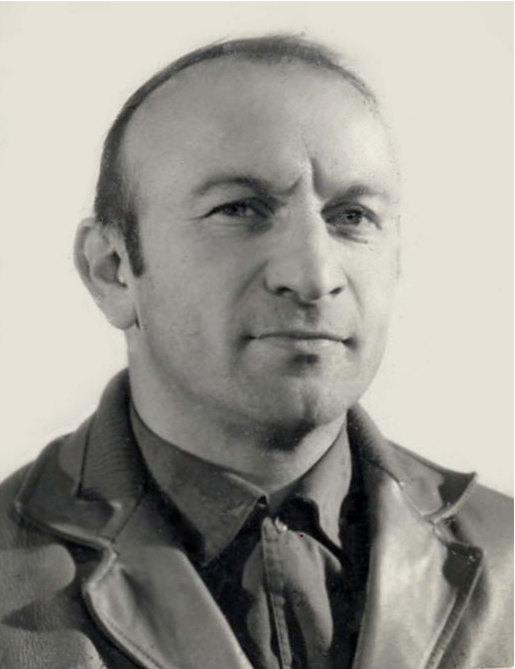
Jean Frelat, 1929-2009
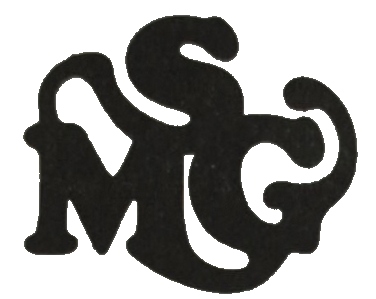 1980s Soudures et Mesures Garanties / SMG
1980s Soudures et Mesures Garanties / SMG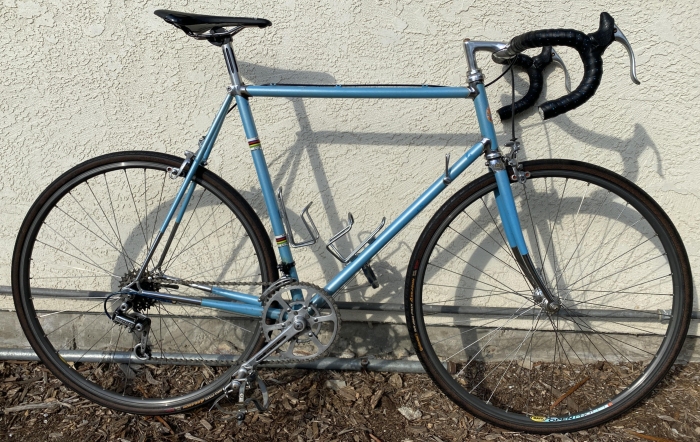
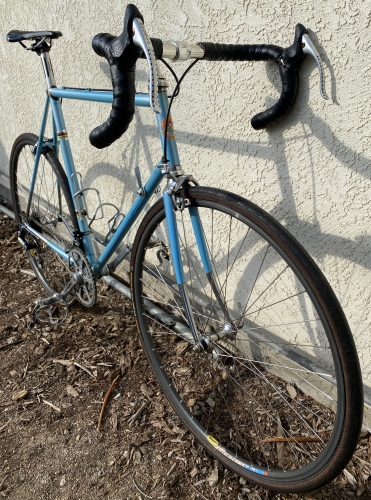
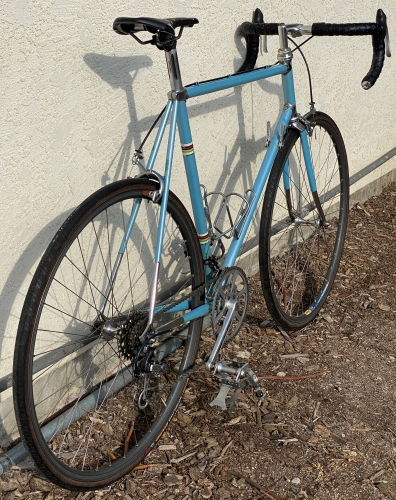

"... I can tell you that this is just a play on words as French people will pronounce it in a way that is the same as the French sentence "Ça c'est beau", meaning "this is beautiful". It might be that Jean Frelat also appreciated that this sounded exotic. I have been in Jean Frelat's workshop back in 1982, when my father was getting his custom randonneuse made by Frelat... "NORRIS LOCKLEY on my SMG (2010):
"... SMG was the brand name of the frames made by Jean Frelat, a constructeur, based at Pavillons-sous-Bois, just to the east of Paris. He was very well known in the late 70s and early 80s, a time when he built quite a lot of frames for leading French amateur riders, on both road and track, who were from that general region of France. He also sponsored several French lady champions such as Isabelle Nicoloso and Valerie Simonet, both of them track riders. Valerie was the French sprint champion in 1981. Jean was quite an innovative builder, being well known for bronze-welded lugless frames and internal routing of all cables.... many of the builders in and around Paris started out as assistants to other builders, and ... Bernard Carre's workshops alone spawned several others such as ... possibly Frelat, ... Jean Frelat who was the brains behind the firm SMG, ran two brands within the one - the SMG brand tended nearly always to be lugged frames whereas he reserved the other name SASEBO ... for his bronze-welded ones. ... the firm had a reputation for custom frames, particularly very small ones, i.e. 46 and 47 cms with 700 wheels. Frelat was a very good marketing man, and for a few years in the late 70s and early 80s, his frames were seldom out of the columns of the French cycling press. He came up with quite a few ingenious designs particularly for track frames - a discipline in which he sponsored quite a few French champions. I think that your frame is from Frelat's later years, i.e. into the mid-to-late 80s; it is the design of the seat lug with its pockets to house the top ends of the seat stays that forms that judgement. This lug is probably an investment cast one from either Everest or Long Shen of Taiwan. Frelat was very loyal to French suppliers using either Vitus or Camus tubes, rarely Reynolds, and sometimes Columbus as this firm had a greater choice. I think that the chances are that your frame is either Vitus or Columbus, with the crown being probably BOCAMA and the bracket Vitus or Dardannne. ... In terms of originality, I reckon that the frame was a custom-build for the guy whose name is painted on the top-tube. Paintwork might have been by a local firm called Vedett ..."ROBERT CLAIR on Classic Rendevous listserver (2008):
"... the LBS had in today something that looked very much like a mid-80's Lotus aero ... but it had SMG decals, a number plate, some sort of engraved fork crowns, rainbow paint, a dual "pinned" seat tube, the usual aero crimped tubes, fillet braze joints, all internal cable routes, etc. ... and a hand cut drilled/fork end in the rear that has two wheel cut out/connections on each sides. It looks as though the one closer to the bb will take a wheel into the crimped seat tube, like a Rigi ... there were also hand cut letters on the side of the frame, the owners name, and an SMG on a seat stay. It also came with a Campy 50th. ..."NORRIS LOCKLEY responds to Robert Clair (2008):
"... The Lotus look-alike frame found by Robert Clair, but badged up and engraved as an "SMG", is in fact of French origin. SMG was the brand name of the frames made by Jean Frelat, a constructeur, based at Pavillons-sous-Bois, just to the east of Paris. He was very well known in the late 70s and early 80s, a time when he built quite a lot of frames for leading French amateur riders, on both road and track, who were from that general region of France. He also sponsored several French lady champions such as Isabelle Nicoloso and Valerie Simonet, both of them track riders. Valerie was the French sprint champion in 1981. Jean was quite an innovative builder, being well known for bronze-welded lugless frames and internal routing of all cables. The frame that Robert has come across sounds as though it is the top-of-the-range SMG, called the SASEBO model. As such all the oval tubes - probably with rounded ends for easy use with lugs - oval stays and possibly fork blades - would be from the AMR - Camus Aero 7 tube set. If the tubes are regular aero section, i.e. without tubular ends, then they will be Columbus Aero ones. The frame will probably not have a rear chainstay bridge, to enable the rear wheel to be brought close to the seat tube. It's a long time since I saw this Frelat model but I think that the drop-outs were one of Frelat's patents, designed to enable the frame to have longer and shorter wheelbases, depending on use. The CAMUS-tubed version was intended for use in pursuit racing and the Columbus-tubed one for sprinting and vitesse. As I recall he also had front fork drop-outs that gave a choice of two positions. SMGs are quite rare frames. ..."NORRIS LOCKLEY on a blue Frelat frame with double seat lug bolts, drilled vertical rear dropouts, and aero seat and head lugs (2012):
"... I think that this is an example of Jean's SASEBO model - his top of the range. ... about shot-in seat stays, this SMG provides an interesting example of the genre - the double-bolt method being one of his favourites. Jean was also very fond of developing his own special drop-outs and I suspect that the verticals on this frame are of his own design, although I am not too keen on the gear hanger being so far to the back, as chain-wrap might prove a bit of a problem. I'm glad that I wasn't picking up his bill for his silicon-bronze welding rods as there is quite a lot of brass/bronze on those welds..but all very nicely filed up. ... I came across a copy of Jean Frelat's price List as printed for the Paris bike show in September 1981; Jean never did produce a catalogue as such.. just simply managed to get the Editor of the influential monthly magazine Le Cycle to keep inserting product reviews of the various bikes produced at the workshop at 61 Boulevard Pasteur, Pavillons-sous-Bois to the NE of Paris. To put this frame, at retail price, into some context it would have cost 2,856.45 francs and would have been built from Columbus SL, making it dearer than a Columbus Aero-tubed frame (was AIR available in 1981 or did Jean squeeze his own sections?) at 2,443.76 presumably with VAT included. In English money at the time, the SASEBO would have set a buyer back about £228.50. These prices were for the frame in 'brut' finish, i.e. unpainted. Like many of the frame-builders in the Paris region, particularly those who wanted something very special, Jean used the firm Vedett'email. SMG boasted a twelve model range of frames built in a selection of tubes such as CAMUS, Ishiwata O15, Super Vitus, Columbus SL and Reynolds 531, 531SL, and 753. All frames could be bought built for any discipline, the price shown being for the basic structure with supplements for braze-ons. The drillium treatment of the rear drop-outs of this SASEBO would have set the customer back a further 91.73 FF or about £7.35 - cheap at the price really, while the internal cables cost 176.40 FF or £14.10. It's interesting to note that Frelat's options for cast bottom bracket shells, ... were as follows, a Cinelli 132.30 FF (£10.60) whereas the ROTO Italian model cost 194.04FF (£15.52)...."NORRIS LOCKLEY on an SMG, seen in the "Jean Frelat information and SMG bikes" PDF linked from this page (2010)
... This particular frame appears to be one of Jean's earlier ones, judging by the SMG engraved on the fork crown; later ones have quite an ornate and often difficult to decipher logo, particularly when the frame happens to be his SASEBO model. In the 70/80s,to the immediate east of Paris in the small towns of Aulnay and Pavillions sur Bois where Jean had his workshop, there were quite a few talented artisan frame-builders such as Alain Michel, Edmund Polchlopek, BACO, Freddy, not to mention Bernard Carre just further to the south east - all of whom produced custom-buiult frames. There was a lot of competition for customers, so the builders developed their own litle trade-mark tweaks. Jean Frelat liked to reprofile the shoulders of the head-lugs to make them more sculptured and interesting; he also experimented a great deal with drop-outs and seat clusters - finally settling on a fast-back type that was secured by two Allen-key bolts. I would place this frame in the late 70s when Frelat was taking the French lightweight trade by storm.. or at laest to a certain extent. His frames were much publicised and featured in magazines such as Le Cycle; around the same time he opened a small boutique shop on the R/H side of the Avenue de la Grande Armee (the other side of the Champs Elysees) where he mixed it with the likes of Chaplait, Oscar Egg, Peugeot, Danguillaume (Mercier), Branton (Lejeune), Bianchi, Benotto, Bossis and AMR - very much custom builders themselves. At about that time a certain Andre Sabliere from the Lyon/St Etienne area was also getting his gas-welded aluminium sculptured frames in the cycling Press. Andre majored on the type of seat cluster featured on this SMG, i.e. a shot-in stay arrangement with no visible means of fixing the pillar into place - the trick being to use a seat pillar with an internal expander bolt. The rear drop-outs on this frame testify to another of Jean's particular obsessions. The owner of this bike appears to have made an effort to select the best of French components with little regard to having 'group sets' as a guide. I'm not too convinced about the choice of the Huret Duopar rear mech.. not on a 'sportif' type bike... maybe a long cage Huret Jubilee would have been preferable. SMG bikes and frames are very rare...maybe they are not drooled over in the way that Herses and Singers are.. but nonetheless they represent the type of excellent custom frames that were available from French artisan builders in those decades. There was a rumour that Frelat had died an untimely death in the 1980s.. but I have since been advised that he is still alive and has managed since the advent of aluminium and carbon frames, to eak out a meagre existence building a few frames and renovating others. I understand that he may well have worked for Forquoin - 'Le Petit Boyautier' who still has a boutique shop in central Paris along the Rue de l'Aqueduct, I think. For anyone in the market for a top quality rare very very French machine, they could do much worse than buy this one.....NORRIS LOCKLEY on a Bernard Carre frame with head and seat lug similarities to Jean Frelat (2011):
The [Bernard Carre] frame is even more interesting because the 'shoulders' of the head-tube lugs have been reprofiled to yield concave curves. This type of work later became to hallmark of Alain Michel, one of the last French KOF builders in his own right, whose workshop was only about a 30 minute ride up the road from Carre's. Jean Frelat, also an incredibly talented builder from the same neck of the woods, also used this style of lug profiling. I am engaged on some fairly extensive research into the Carre firm, and have reason to believe that both Michel and Frelat trained with Carre...and then moved on. Unfortunately Alain Michel was killed in an accident a couple of years ago, but Frelat is still surviving, just, building a very few steel frames from a small workshop in central Paris...the [Carre] fast-back treatment is not of the more solid treatment developed by Jean Frelat ... who might just have worked for the Carre firm. Francophiles would do well to look out for Frelat's work as well as Alain Michel's. Frelat's company was called SMG... On occasions Frelat added the name SASEBO... mainly in reference to his lugless frames. I recognise that SASEBO is a Japanese word, and the name of a town in that country, but wonder whether it is connected too with track racing because many of the SMGs carrying that extra specification were track frames [Peter Brueggeman notes that there is a Sasebo Keirin Stadium]....I must find time to research the links between Carre and Frelat a little further, particularly as the fast-back stays on Peter's [Brueggeman] frame are very similar to those on the ... Carre.The seller OLIVER DAHNHARDT responds to my inquiry on this bike (2010):
"... I think also that this frame is unusual. The Gipiemme drop outs, that the frame has no eyes to put mud guards on and the brazed on gear lever supports for the Shimano levers, it is unusual when you compare it with other French classic frame builders of this time (for example I have found an Alain Michel for my son with "Shimano" drop outs). The seat tube diameter is 26,6mm, there was a SR Royal seat post on the frame. A few time ago I have sold another SMG frame which was also made with the same gear lever supports. I can't say if the frame builder was Mister Frelat. I have bought the whole bike from a man in the north of France, who had bought it "used" in a bicycle shop near by Paris. All components were a mix of Shimano, Campagnolo, Maxi-car hubs, Philippe (stem and handlebar), Mavic parts. I have also a doubt for the frame tubes. 26,6mm seat tube, maybe it will be Vitus tubes. Also the frame weight is not the lightest. One thing is sure if you will ride the frame one time you will like it. For me the frame is too high, but I have tried it before, and it is made for long distance riding. ..."DATING MY FRAME:
Bike frame is 1980s. The name Michel Stibler is in script on the top tube; Stibler has three Paris-Brest-Paris results (below), with the first one in 1983. The Audax Club Parisien sticker on the head tube is the club which hosts PBP.
- 1983 finisher: 74:23 / 2252 - Michel Stibler, FR - VC Veterans et Ancetres
- 1991 non-finisher: 82:08 / 457 - Michel Stibler, FR - Club Sportif Loisirs Rosny/Bois
- 1995 finisher: 79:56 / 136 - Michel Stibler, FR - Club Sportif Loisirs Gend. Rosny/Bois